
Mar 26, 2021 | Articles
For Accredited Investors Only as defined in the Monetary Authority of Singapore Securities and Futures Act (Cap. 289) and its subsidiary legislation. For Professional Investors Only as defined in the Securities and Futures Ordinance (Cap 571, Laws of Hong Kong) and its subsidiary legislation. This advertisement has not been reviewed by the Monetary Authority of Singapore.
Dear Clients,
As we move towards the official launch of our second fund which invests into Japanese hospitality real estate in early April, our Japanese Real Estate team have prepared the first of a three part thought leadership series looking at a key investment asset within our portfolios; Japanese boutique hotels or “Ryokan’s” as they are known in Japan. Over the coming weeks we will explore Ryokan’s and our goal is to help our investors to develop a greater understanding of these traditional and very unique hospitality assets found throughout Japan. Starting with today, and continuing over the coming weeks, our series on Ryokan’s will feature the following topics:
Part One: What are Ryokan’s, how do they operate and what are the key features?
Part Two: Sector Analysis – what are the emerging trends, dynamics and unique selling points of Ryokans?
Part Three: Investment thesis and case study of Ryokans
We hope you find part one interesting and informative first step into understanding the world of Ryokan’s and we look forward to sharing parts two and three soon.
Please click here to access Part One: What are Ryokan’s, how do they operate and what are the key features?
If you like to receive more information, please contact:
James Wheeler
Managing Director – Head of Distribution
james.wheeler@odyssey-grp.com
www.odyssey-grp.com
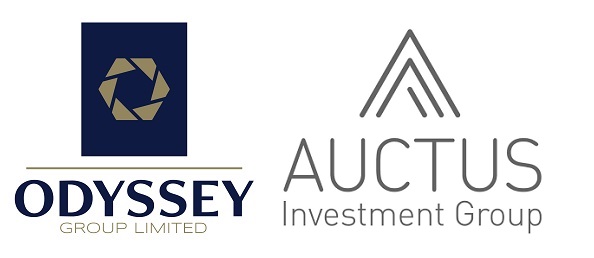
Mar 10, 2021 | Press Releases
For Accredited Investors Only as defined in the Monetary Authority of Singapore Securities and Futures Act (Cap. 289) and its subsidiary legislation. For Professional Investors Only as defined in the Securities and Futures Ordinance (Cap 571, Laws of Hong Kong) and its subsidiary legislation.
KEY POINTS:
- Strategic Partnership with a ASX listed company, Auctus with similar business model
- Auctus to acquire an initial 9.9% stake in Odyssey Group
- Auctus has the option to increase their stake to 100% over the next 2 years subject to regulators’ required approvals
Odyssey Group Limited (‘Odyssey’) is pleased to announce the strategic partnership with Auctus Investment Group Limited (‘Auctus’). Auctus has agreed to an initial investment of US$500K (made out in cash) for a 9.9% stake in Odyssey Group with the option to increase their ownership in the next 2 years subject to regulators’ required approvals. The initial investment will be used for working capital as Odyssey continues to expand its distributions across Asia.
Odyssey Group Limited (‘Odyssey’) was founded in 2016 and is one of Asia’s leading private market asset managers. Odyssey aims to seek out undervalued investment opportunities across multiple asset classes including private real estate, alternative credit and private equity, to co-invest with its clients.
Auctus Investment Group Limited (‘Auctus’) is an ASX listed (AVC:AU) global investment manager with in-excess of A$320M Assets Under Management (AUM), focusing on opportunities across private equity, infrastructure and private real estate. Auctus provides access to these private market investments for wholesale, Family Office and sophisticated investors.

Odyssey Co-Founder and CEO, Alex Walker said “Odyssey has been seeking the right strategic investor for the past 12months and I believe we have found this in Auctus. Both companies share an entrepreneurial mindset and a keen focus on delivering value to our clients. The Odyssey team and I look forward to working with the Auctus team to further tap into the High Net Worth individuals and Family Offices across Asia Pacific region, as well co-investing into attractive investment opportunities that Asia has to offer. It is worth noting, according to UBS, APAC held the highest proportion of ultra-high net worth individuals at 38% with a total net wealth of US$3.3 trillion as compared to 762 (35%) across the Americas and 596 (27%) in Europe, the Middle East and Africa (EMEA). Furthermore, Bain’s Asia Pacific Private Equity Report stated the lack of accessibility of quality private investments in Asia has contributed to unspent capital hitting record highs in 2019”.
Odyssey and Auctus are excited about the partnership due to their similar business models in sourcing undervalued private market investment opportunities and the rising trend of HNW individuals and institutions increasing their asset allocation into private markets in the Asia Pacific region.
The partnership will provide Odyssey with expansionary capital to focus on increasing distribution capabilities and product roll-out across the region. Auctus will gain Odyssey’s AUM of over US$175 million, network, team, and product distribution channels.

Auctus Managing Director, Campbell McComb said “We have high conviction about the outlook of Asian investors’ appetite for private market investments due to limited supply and increasing allocations. We look forward to working with Alex, Dan and the Odyssey team.”
Odyssey Co-Founder and President, Dan Vovil further added “according to PwC’s 2025 Asia-Pacific Report, Asian investors are looking to increase their allocation to private market investments, with growth expected to increase from the market size from US$2.7 trillion in 2017 to US$6.9 trillion in 2025, a CAGR of 11.7%. With this high level of growing demand for private market investment opportunities in Asia and our combined footprint with Auctus, this will provide a superior platform for providing Asian investors access to unique private market products”.
For press enquiries, please contact:
James Wheeler
Managing Director – Head of Distribution
press@odyssey-grp.com
www.odyssey-grp.com
www.auctusinvest.com

Mar 10, 2021 | Articles, Global Markets Update
March 2021 Insight
Inflation is a Dirty Word
If there was one factor that could knock the rally in risk assets on its head is the specter of inflation. That would remove the easy money that has been fueling markets. Right now, it is just the speculation of inflation as indicated by moves in the 5Y treasuries and beyond. Certainly, we have seen some positive inflation in recent data, and that’s a good thing. If we didn’t, it would mean the global economy was not recovering and the markets would have something far worse to contemplate. Indeed, if the recovery accelerates with the distribution of vaccines, headline inflation (CPI) may well surpass the often quoted 2% target in the next couple of quarters term due to low comparisons in Q2 2020 when US CPI fell close to zero. Further, the World Commodity Index has surged 63% since April 2020, which represents large rises in energy and raw material prices.
While headline inflation may cause concern for markets, most governments base monetary policy on some form of core inflation that often excludes food and energy prices. The US Fed favours the Core Personal Consumption Expenditure (PCE) Index as one its measures and this has not been above 2.5% since 1993. Indeed, there has been a falling trend in the PCE over the last 50 years and this unsurprisingly has coincided with the fall in unit labor costs per real GDP. The only time it has sustained above 2% for any length of time in the last 25 years was during the credit bubble of 2004-2008 when it was continually just above 2%. What has been driving this disinflation? My own opinion is that the root cause is accelerating technology adoption and diminishing wage growth due to an ageing working population. In 1999, workers of age 55+ were just 12.7% of the workforce. By 2019 this had almost doubled to 23.4% and by 2029 the U.S. Bureau of Labor Statistics forecast this age group to comprise 25.2% of the workforce.
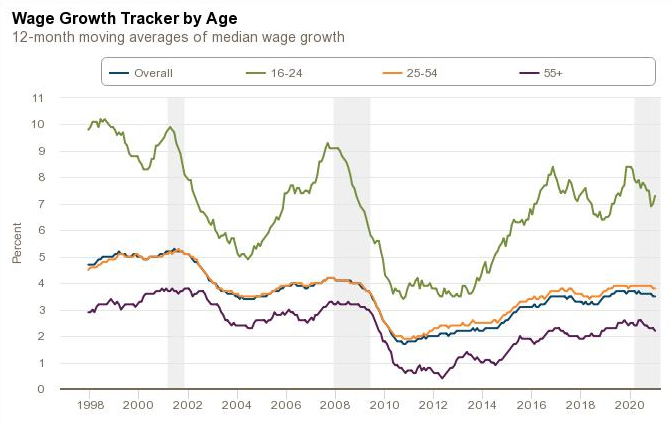
Source: Federal Reserve Bank of Atlanta
Since I am expecting these root forces to continue, it is not expected that the PCE Index to sustain above 2% for an extended time. From the Fed’s dovish comments, we appear to agree. However, the US yield curve is pricing in a rate hike as early as 2023 which is obviously earlier than the Fed’s expectation. Apart from jaw-boning, there is little the Fed can do to affect pricing several years beyond the target rate. The current 2Y-10Y differential is at 1.45%, above the previous spike of 1.34% in December 2016 and close to a potential resistance at 1.5%. Prior to that we had spikes to 1.76% in June 2015 and 2.61% in December 2013. In terms of absolute level of the 10Y UST, the 1.59% yield is similar to that in 2016 and 2012.
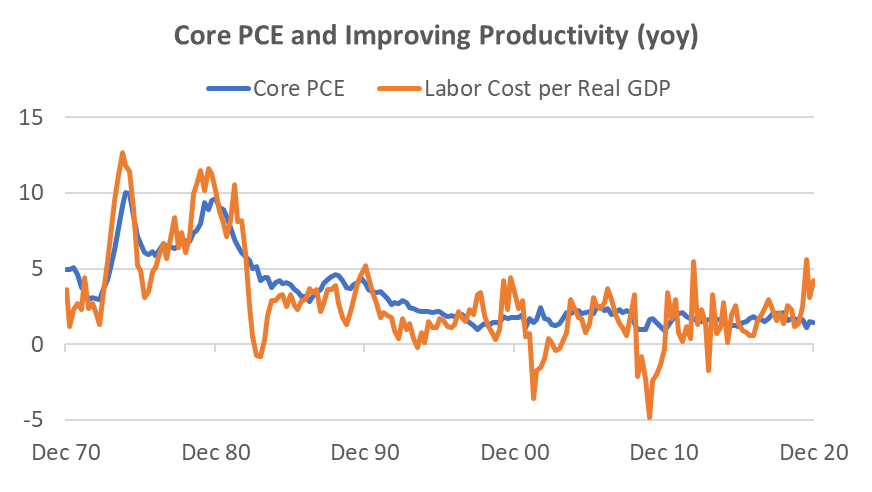
Source: Bloomberg

Source: Bloomberg, Odyssey
The Pain Trade in Rates
Several generations of bond traders have made fortunes from being long bonds – making money from when bond yields fall. That is because this has been the trend for three decades. Few traders like to short bonds, because they are betting against the trend. In addition to the specter of inflation, rising bond yields can have significant momentum for a time; everyone is betting in one direction and with significant leverage (often 10x or more). As the bond yields rise and prices fall, it becomes a pain trade for bond traders, and it ends up being a scramble to close out their long positions. The other marginal large player in rates are the large CTA (commodity trading advisors) funds that are followers of directional trends. Commentary suggest they close out their long bond positions in January and started to build up short positions in February. Trend algorithms do not have a human trader’s reticence or care about fundamentals.
Usually when bond yields rise, bond traders have an inkling that either inflation is rising faster than expected or that the government is about to alter monetary policy. In this case, we have only glimpsed the barest evidence of inflation and the Fed has been steadfast in its monetary policy. This is a reason why the bond market and equity investors have been caught a little off-guard, and probably why yields have been higher than what might be expected from fundamentals. Are yields heading even higher? Since the answer appears more technical rather than fundamental, then the short answer is that it is certainly possible.
Dealing with Adjustment Pains
It is not helpful when a market commentator says that the current clearing out in stocks is good for medium and long-term returns when you are losing money. The good news is that blue-chip stocks have been highly resilient. The S&P500 is down less than 3% from its peak and major European burses have hardly moved. In fact, US Value stocks continued to climb another 3% since the S&P500 peak and Banks are up +9%. It’s been the high growth and speculative stocks that have suffered. The Nasdaq has fallen 10% and MSCI China has fallen 16%. Speculative ETFs have fallen 20-30%. In terms of technicals, it’s worth noting that the Nasdaq has hit it’s 100-day moving average. However, the trend of the UST 10Y is likely to remain a major factor.
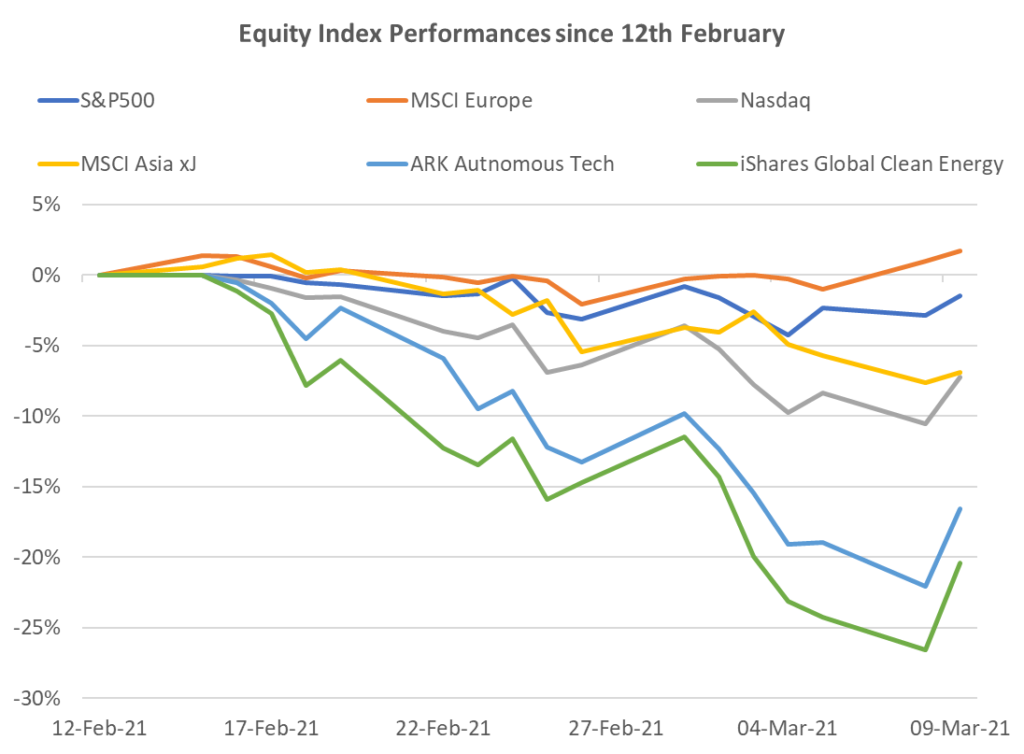
Source: Bloomberg, Odyssey
Mixed Bag in Other Markets
We have been warning about the temptation to buy long duration credit for yield since November last year. The Global Corporate Credit Index is down -4% YTD and US Investment Grade is down -5%. Global HY is largely flat YTD due to lower duration and assisted by a higher carry.
The one asset class that has unequivocally benefitted from the stronger economic outlook has been commodities. The London Metals Index is up +9% YTD, with copper up +14%. WTI Oil is +14% YTD and has moved in virtually a straight line up since the beginning of the year. The main commodity to suffer has been gold which is down -7% YTD and has lost some of its lustre due to the popularity of cryptocurrencies.
Investment Recommendations
When Boring is Good
Back in November 2020 when the Value v Growth issue in stocks first arose, we chose a slightly different tact. We suggested a 3 stock basket that was non-tech and seemed to perform in a steady fashion regardless of whether Value or Growth was favoured. The basket comprised UnitedHealth, Abbott Labs and Morgan Stanley. Since the end of November, the basket is up +14% and up +2% since the recent peak of the SPX500 on February 12. These have not been flashy stocks but together they would have helped to stabilize any equity portfolio and provided significantly better than market returns. All three have announced solid Q4 operational results and we have no qualms about continuing to recommend these stocks, particularly as a basket.
Value in Tech Yet?
Despite the recent 10% fall in the US Infotech sector, the 1-year forward PER at 30x remains 40% higher than the 10-year average at 21x. Some of this is due to the 41% weight to Apple and Microsoft, but there is no denying the sector remains expensive. Nevertheless, the US Infotech sector has hit the 100-day moving average and if we can get some respite from rising rates, the potential for a technical bounce is possible. There are plenty of stocks that we have previously recommended that had very strong Q4 results but have fallen 20-25% to what appears to be technical support levels. These include Paypal, Activision Blizzard, and TSMC to name just three. However, to find one that is trading close to pre-COVID valuations is more difficult.

Source: Bloomberg, Odyssey
One such stock is Google. We rarely featured this FAANMG last year because its peers were overshadowing its performance, but the last two quarters have seen a marked operational improvement to firmly catch up with its peers. It has been a major beneficiary of the recovery in online advertising spend, but it is not burdened with as many political and sentiment issues as Facebook. In particular, its Youtube business has been riding a wave of popularity, and with a new product suite, the 45% revenue growth in Q4 2020 is expected to remain strong. Further, while Amazon and Microsoft continue to dominate cloud infrastructure, Google Cloud’s large customer acquisition program has started to improve, demonstrated by 46% revenue growth. Finally, Search remained a very solid performer with 17% revenue growth. At a valuation of 29x 2021 earnings, the stock is trading only slightly high to its usual range of 25-30x over the last 5 years. The stock has shown resilience during the growth sell-off and has only fallen 4% from market peak to trough.
Odyssey Model Portfolio Performance

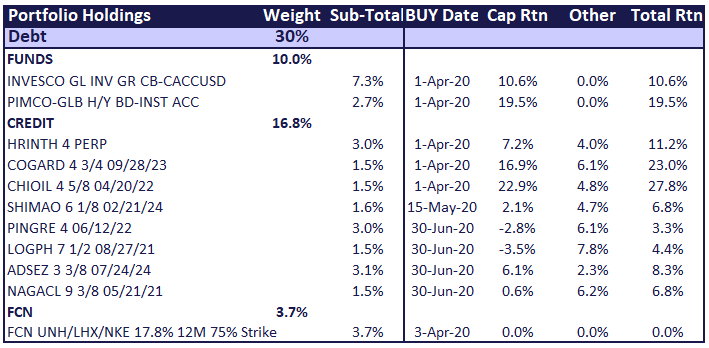
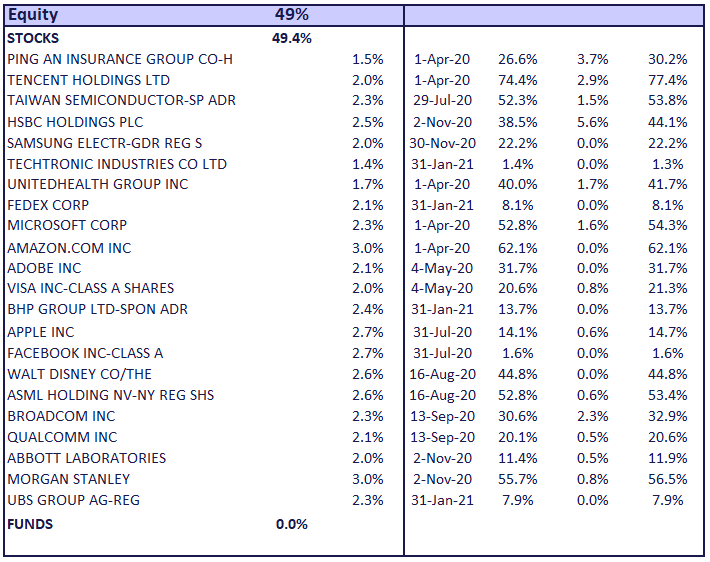

Horizon Performance

If you like to receive more information on our portfolios solutions, please contact us here: info@odyssey-grp.com.

Feb 10, 2021 | Articles, Global Markets Update
February Market View
Wall Street meets Social Media
The evolution of social media has turned into a revolution for the financial markets. Ten years ago, the mostly forgotten Arab Spring showed how nascent social media could galvanise the populace to cause social and political change. More recently we’ve seen social media propel the #MeToo movement, Donald Trump tweeting over 26,000 times as the POTUS and often using it to announce official news, Russia being accused of using social media to affect the 2016 US elections, as well as being used in the recent protest on Capital Hill. Now the financial markets are experiencing how effective social media can be in moving asset prices.
Chart: Bitcoin and Gamespot price
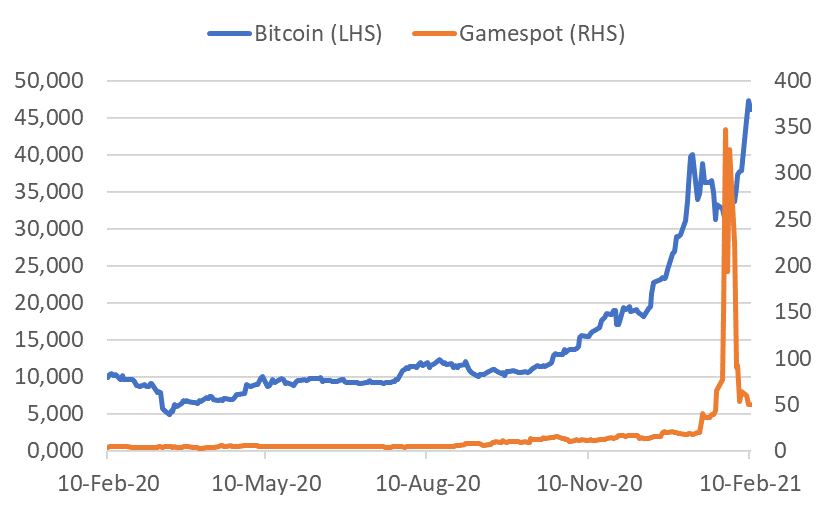
Source: Bloomberg
Dramatic price moves have occurred in Gamestop, AMC, and now Bitcoin through actions on social media. What does the increase in the use of social media platforms bode for investing? The use of social media for investment research has been prevalent for close to a decade. The rise of the “retail” or DIY investor can be seen by the massive growth fund flow to ETFs at the expense of the active manager. In recent months, the move has also transferred to individual stocks and stock options and this has been cited as a major reason behind the rally since November.
Chart: Net Call Option buys with less than 10 contracts on individual equities

Source: J.P. Morgan
The strength of the retail buying may be a major factor in market direction, at least in the short term. However, for most of us, monitoring retail flows may not be convenient or timely. What may be of use is the knowledge that this recent input to flows could lead to (and has led to) movements in stocks and ETFs to levels that defy valuation. On the flip side, when a popular stock disappoints, it could lead to buying opportunities as buyers hollow out. While most studies have focused on the impact of social media on small cap stocks, it would not surprise if retail also had an appreciable impact on popular big-cap stocks. Perhaps it was a factor Apple’s surge in August last year and subsequent fall in September. In short, we have seen and can continue to expect excessive movements that could lead to both buying and selling opportunities as stocks rise and fall in popularity.
Who will Blink?
Bears keep pointing to sky-high equity valuations, a very hot IPO market, record volumes, and the parabolic performance of certain thematic baskets where the majority of companies are unprofitable. Bulls see a recovering economy, particularly in the US, unprecedented stimulus, zero interest rates for the foreseeable future, the fastest vaccine rollout in history, and negligible inflation. As a short-term fillip, with over half the S&P500 companies having reported, 80% have beaten the consensus EPS estimate, and by a whopping 19%, with a 4% topline surprise. The story is similar in Europe and Japan, albeit to a lesser degree.
For the moment, the bulls are winning and as we saw in the 1990’s, a frothy market can last for longer than many bears can hold out. Nevertheless, we make no prediction on short-term direction, but suggest clients to analyse stocks at face value. For instance, on the claim there is a lack of inexpensive stocks, we propose three big cap examples – UnitedHealth, Qualcomm and FedEx. All have forward PERs in the teens and are expected to report robust operational numbers this year with or without COVID. Facebook is also worth mentioning with a forward PER that is below the S&P500 average. This is the first time that has occurred since Facebook listed in 2012. These are not poorly performing stocks – they have all outperformed the S&P500 over the last 12 months. However, you could say they are currently a little out of favour. This segues back to our earlier suggestion that the retail trade can well help to provide opportunities to buy quality stocks that are unpopular.
Chart: Performance of Select Inexpensive stocks

Source: Bloomberg, Odyssey
Horizon Performance
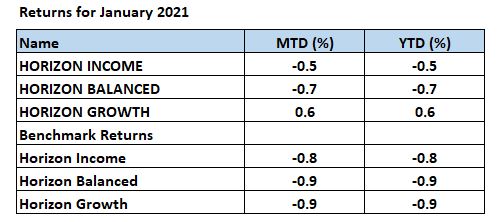
If you like to receive more information on our portfolios solutions, please contact us here: info@odysseycapital-group.com

Jan 13, 2021 | Press Releases
Introducing Mr John Kakita プロフィール 垣田宜廣氏
 オデッセイ・アセット・マネジメント・リミテッドはオデッセイ・ジャパン不動産部門担当マネージングディレクターに垣田宜廣氏を任命しました。垣田氏は、ファンドやシンジケートによる新規ホスピタリティアセット買収、そのオペレーション及びマネジメント全般を含めた国内の不動産プロジェクトを統括します。
オデッセイ・アセット・マネジメント・リミテッドはオデッセイ・ジャパン不動産部門担当マネージングディレクターに垣田宜廣氏を任命しました。垣田氏は、ファンドやシンジケートによる新規ホスピタリティアセット買収、そのオペレーション及びマネジメント全般を含めた国内の不動産プロジェクトを統括します。
垣田氏は、過去20年間、この業界で様々な要職を歴任してきました。ヒルトン・インターナショナル 日本・ミクロネシア地区セールス&マーケティングディレクターとしてグローバルホテルチェーン運営管理に携わった後、ゴールドマン・サックス・リアルティ・ジャパンでは新たに導入したREIT資産を含む4~5つ星ホテルポートフォリオのアセットマネジメント部門を率いました。日本の大手不動産会社で5つ星ホテルの開発に責任者として従事した経験も持ちます。
直近では、東京の不動産ファンド企業のCIOとして、由緒ある温泉旅館をはじめとしたホスピタリティアセットの開発・資産管理に投資家の立場として携わりました。
垣田氏は、早稲田大学法学部卒業、米国ノースウエスタン大学ケロッグスクールでMBAを取得しました。
Mr John Kakita’s Role at Odyssey 垣田氏の役割
この豊富な経験と実績で、この程立ち上げたオデッセイ・ジャパン・ホスピタリティ・ファンドIIで、より付加価値を生み出す潜在性のある日本の旅館不動産投資へ取り組むことになります。ファンドの主要戦略は、日本の旅館を買収し、リニューアル、リポジション、より質の高い運営することで、お客様に魅力的なおもてなし体験を提供すると同時に、投資家へも魅力あるリターンをもたらすことです。
このファンドがメインにターゲットとするのは、ラグジュアリーブティックホテル、旅館、町屋といったアセットタイプです。その3タイプのいずれかへリニューアル可能で、日本有数の観光地にある歴史遺産的建造物が投資対象となります。
オデッセイ・ジャパン・ホスピタリティ・ファンドIIについて更に詳しい内容は、馬場ゆきまで日本語にてお問い合わせください。yuki.baba@odysseycapital-group.com
Click here to download the full article.
Why Choose Odyssey? オデッセイが選ばれる理由
オデッセイ・グループ・リミテッドは、アジアのミッドマーケットをリードするオルタナティブ アセット マネジメント企業です。オルタナティブ・クレジット、不動産、プライベート・エクイティ、ヘッジファンド等資産クラス別マルチアセットを取り扱い、差別化を図り、ご要望に応じた投資ソリューションを提供します。クライアントと共同で潜在的に付加価値を生み出せる資産への投資機会の発掘に注力します。
オデッセイチームには、37名以上の経験豊富なアセットマネージャー、弁護士、プライベートバンカー、信託・税務プランの専門家、ベテラン投資家といった各分野の優秀なメンバーで構成されています。アジア太平洋地域、ヨーロッパ、北米においてそれぞれ平均22年に及ぶファイナンス、執行、運用の実績をもちます。
オデッセイチームのこの経験こそが、リージョナルの幅広い業界専門知識、グローバルマクロ経済や地政学的トレンドの洞察と強力なグローバルネットワーク関係構築を可能にします。
目標とする成果達成のために総力をあげて取り組むことで、オデッセイ・グループと提携するクライアントには幅広く深い専門知識をお役立ていただけます。
当社の革新的なアプローチは、慎重かつ長期的な視点で魅力的な投資収益を生み出します。
投資パートナーとの高水準で長期的な利益の一致を追求するために、ビジネスパートナーとして高い能力をもつプロフェッショナルがオデッセイには揃っています。お客様のニーズに応える「信うr頼のパートナー」となることが私たちの信条です。
弊社へのお問合せ・アジアで最も魅力あるオルタナティブ投資機会について更にお知りになりたければ、馬場ゆきまで日本語にてお問い合わせください。yuki.baba@odysseycapital-group.com
このプレスリリースコンテンツはご自由にシェアいただけます。






















 オデッセイ・アセット・マネジメント・リミテッドはオデッセイ・ジャパン不動産部門担当マネージングディレクターに垣田宜廣氏を任命しました。垣田氏は、ファンドやシンジケートによる新規ホスピタリティアセット買収、そのオペレーション及びマネジメント全般を含めた国内の不動産プロジェクトを統括します。
オデッセイ・アセット・マネジメント・リミテッドはオデッセイ・ジャパン不動産部門担当マネージングディレクターに垣田宜廣氏を任命しました。垣田氏は、ファンドやシンジケートによる新規ホスピタリティアセット買収、そのオペレーション及びマネジメント全般を含めた国内の不動産プロジェクトを統括します。